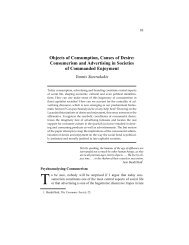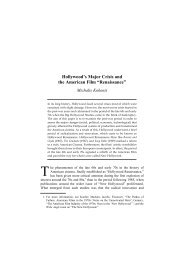19 International Symposium on Theoretical and Applied Linguistics ...
19 International Symposium on Theoretical and Applied Linguistics ...
19 International Symposium on Theoretical and Applied Linguistics ...
You also want an ePaper? Increase the reach of your titles
YUMPU automatically turns print PDFs into web optimized ePapers that Google loves.
G E N E R A L S E S S I O N<br />
Frazier, L. <str<strong>on</strong>g>19</str<strong>on</strong>g>87. Syntactic Processing: Evidence from Dutch. Natural Language <strong>and</strong> Linguistic Theory, 5, 5<str<strong>on</strong>g>19</str<strong>on</strong>g>-<br />
559.<br />
MacD<strong>on</strong>nald, M.C., Pearlmutter, N.J. & Seidenberg, M.S. <str<strong>on</strong>g>19</str<strong>on</strong>g>94. Syntactic ambiguity resoluti<strong>on</strong> as lexical<br />
ambiguity resoluti<strong>on</strong>. In: C. Clift<strong>on</strong>, L. Frazier & K. Rayner (Eds), Perspectives <strong>on</strong> Sentence Processing, (pp.<br />
178-269). Hillsdale, N.J.: Lawrence Erlbaum.<br />
Mitchell, D. C. & Cuetos, F. <str<strong>on</strong>g>19</str<strong>on</strong>g>91. The origins of parsing strategies. In C. Smith (Ed.), Current issues in natural<br />
language processing. Austin: Center for Cognitive Science, University of Texas.<br />
Rayner, K., Carls<strong>on</strong>, M. & Frazier, L. <str<strong>on</strong>g>19</str<strong>on</strong>g>83. The interacti<strong>on</strong> of syntax <strong>and</strong> semantics during sentence processing:<br />
Eye movements in the analysis of semantically biased sentences. Journal of Verbal Learning <strong>and</strong> Verbal<br />
Behavior, 22, 358-374.<br />
Spivey-Knowlt<strong>on</strong>, M. & Sedivy, J.C. <str<strong>on</strong>g>19</str<strong>on</strong>g>95. Resolving attachment ambiguities with multiple c<strong>on</strong>straints. Cogniti<strong>on</strong><br />
55, 227-267.<br />
Referential agreement in MG coordinate NPs<br />
Despina Kazana<br />
University of Essex<br />
dkazan@essex.ac.uk<br />
Gender resoluti<strong>on</strong> in coordinate noun phrases is interesting for a number of languages due to the<br />
existence of two resoluti<strong>on</strong> principles, the syntactic <strong>and</strong> the semantic <strong>on</strong>e (Corbett (<str<strong>on</strong>g>19</str<strong>on</strong>g>83, <str<strong>on</strong>g>19</str<strong>on</strong>g>91);<br />
Dalrymple <strong>and</strong> Kaplan (2000); Sadler (2006); Wechsler <strong>and</strong> Zlatic (2003)). A challenging issue is that<br />
not all languages follow the aforementi<strong>on</strong>ed distincti<strong>on</strong>. An analysis of Modern Greek coordinate<br />
nouns showed that a group of patterns does not comply with the characteristics of these two<br />
principles. The aim of this paper is to prove that a third gender resoluti<strong>on</strong> principle is involved in MG<br />
coordinate phrases <strong>and</strong> examine whether the attested patterns are exemplified by the current<br />
agreement theories.<br />
Two central theories of gender resoluti<strong>on</strong> have been proposed within the framework of Lexical<br />
Functi<strong>on</strong>al Grammar. Dalrymple <strong>and</strong> Kaplan (2000) propose a syntactic account of gender resoluti<strong>on</strong><br />
using a set-based theory of feature resoluti<strong>on</strong> in coordinate c<strong>on</strong>structi<strong>on</strong>s. GENDER is represented as<br />
a set-valued rather than an atomic feature while syntactic resoluti<strong>on</strong> is calculated by the simple<br />
operati<strong>on</strong> of set uni<strong>on</strong>. The value of the GENDER feature of the coordinate phrase as a whole is the<br />
smallest set c<strong>on</strong>taining the values of the individual c<strong>on</strong>juncts. Wechsler <strong>and</strong> Zlatic (2003) propose the<br />
’Elsewhere’ principle, which combines syntactic <strong>and</strong> semantic gender resoluti<strong>on</strong>. Animate nouns<br />
display syntactic resoluti<strong>on</strong>, if the NP has a head with a gender value, or semantic resoluti<strong>on</strong>, if the NP<br />
lacks an inherent gender or lacks a head noun, having no inherent lexical gender feature, as in<br />
coordinate phrases. Inanimate nouns display syntactic resoluti<strong>on</strong>, following the c<strong>on</strong>straint <strong>on</strong><br />
inanimate aggregate discourse referents. The gender value of empty-genders (inanimates), which lack<br />
semantic correlates, is calculated if we remove the empty-gender features from the intersecti<strong>on</strong> of the<br />
gender features for group-denoting NPs with the semantic-gender (animates) features.<br />
MG animate coordinate nouns follow semantic resoluti<strong>on</strong> according to which identical gender<br />
nouns resolve into the gender of the c<strong>on</strong>juncts, whereas mixed gender nouns resolve into masculine.<br />
MG inanimate coordinate nouns follow syntactic resoluti<strong>on</strong> in which identical gender c<strong>on</strong>juncts resolve<br />
into the gender of the c<strong>on</strong>juncts but mixed gender c<strong>on</strong>juncts resolve into neuter. A number of patterns,<br />
however, display alternative resoluti<strong>on</strong> results. In particular, animate nouns with f.pl+n.pl c<strong>on</strong>juncts<br />
may also resolve into n.pl <strong>and</strong> not <strong>on</strong>ly into m.pl, irrespective of the order of the c<strong>on</strong>juncts. Similarly,<br />
inanimate nouns with the gender combinati<strong>on</strong> m.sg+m.sg resolve into n.pl, apart from the m.pl<br />
resoluti<strong>on</strong>. Finally, an inanimate phrase with m.pl+f.pl nouns resolves mainly into m.pl as opposed to<br />
n.pl. The above cases c<strong>on</strong>firm the existence of a third type of gender resoluti<strong>on</strong> principle which is<br />
referentially motivated. The agreeing element (’target’) is morpho-syntactically determined by an<br />
implied noun that functi<strong>on</strong>s as the superordinate referent of the coordinate phrase.<br />
Thus, I will show that MG data supports the recogniti<strong>on</strong> of an extra gender agreement principle but<br />
the present approaches are inadequate to exemplify such patterns. A further questi<strong>on</strong> to explore is<br />
whether any theory can adequately account for these referential agreement patterns.<br />
References<br />
Corbett, G. G. <str<strong>on</strong>g>19</str<strong>on</strong>g>83. Resoluti<strong>on</strong> rules: Agreement in pers<strong>on</strong>, number <strong>and</strong> gender. In G. Gazdar, E. Klein & G. K.<br />
Pullum, ed., Order, c<strong>on</strong>cord <strong>and</strong> c<strong>on</strong>stituency, pages 175–206. Dordrecht: Foris.<br />
Corbett, G. G. <str<strong>on</strong>g>19</str<strong>on</strong>g>91. Gender. Cambridge: Cambridge University Press.<br />
Dalrymple, M. & Kaplan R. 2000. Feature Indeterminacy <strong>and</strong> Feature resoluti<strong>on</strong>. Journal of Language 76(4).<br />
Sadler, L. 2006. Gender resoluti<strong>on</strong> in Rumanian. In M. Butt, M. Dalrymple & T. H. King, eds., Intelligent Linguistic<br />
Architectures: Variati<strong>on</strong>s <strong>on</strong> Themes by R<strong>on</strong> Kaplan, pages 437–454. CSLI Publicati<strong>on</strong>s.<br />
Wechsler, S. & Zlatic L. 2003. The Many Faces of Agreement. CA: CSLI Publicati<strong>on</strong>s.<br />
<str<strong>on</strong>g>19</str<strong>on</strong>g> th ISTAL 27






